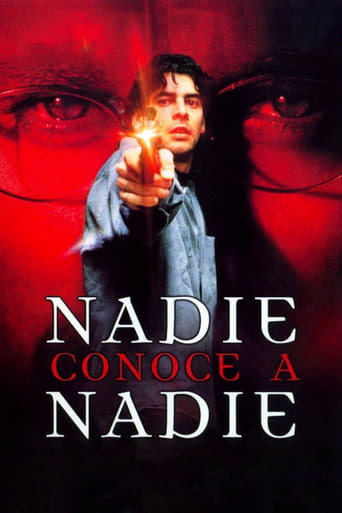FilmFatale
Spanish-made suspense/action film with horror overtones.It's the last Holy Week of the millennium in Seville and crossword puzzle creator Simon Cardenas finds himself at the center of a religious mystery. Things just keep getting crazier and crazier for poor Simon. I'd say this is geek suspense at its finest. Interesting use of role-playing gamers and religious conspiracy, and crossword puzzle fans like myself may look for hidden messages in the NYT Sunday puzzle for a few days. Plus, I love "who do you trust" stories and I adore the fabulous gorgeous-ness of Eduardo Noriega, so this couldn't really fail for me. I thought it was a great little flick that kept me engaged and entertained all the way through.
Oslo Jargo (Bartok Kinski)
This little film from Spain has a story to tell, too bad it takes place mostly in the beginning. It deals with hidden witches covens which are scattered throughout Sevile Spain and it has as its main character, a pseudo-intellectual who writes boring crossword puzzles for the main paper, "El Hergizito". Soon he finds himself in a mysterious world of terror which he can not fathom. I was quite interested until the story became a cliche taken from American films and then it became just average on the whole. Most of the derailment took place in a scene where there are numerous men in hoods shooting laser guns in a 'game" that really looks stupid, from there, we learn that the coven of 'Satanas" wants to destroy Seville. His former roommate is the brain child of a group of degenerate loser and misfits, whom he later blows up in another absurd scene, (why kill them off?). The ending is typical and even expected, because he finds the evil guy and shoots him dead, and at the end, it was all just a novel, but we aren't sure are we?
Alice Liddel
'Nobody knows anybody' is a conspiracy theory thriller about a Satanist/nut bomber targeting the religious festivities of Seville during Holy Week. He also happens to be the best friend of the film's hero. The plot is set up by the bomber as a computer game, with himself and the hero as players, and Seville as the virtual environment. The very real alleys and streets of the city begin to take on the labyrinthine qualities of those old Pacman-type games. Looked at this way, the scene where the hero and his female sidekick are chased by black-hooded penitents with rayguns may not seem as silly as it plays. From the start, we are aware that the narrative is being constructed as a game - the hero's job is to create crossword puzzles for a popular newspaper; at one point, the crossword grid on his screen becomes the chessboard on which he is later playing against his girlfriend's father. Clues are liberally scattered, as the camera mystifyingly closes in on images that are only later shown to have been significant (e.g. the advert in the bar). The detective/paper chase elements are made part of a game in progress, rather than an investigation after the fact. The film borrows heavily on 'Se7en''s pattern narrative, and anyone with a Catholic education will presumably get the significance of certain events happening on certain days in the run up to EAster.In this reading, the game is on the level of narrative, with the hero fighting against an enemy (in this case, the computer) to win and save the day. But there is a second game, the film itself, which subvert the first. There are another set of of clues which point not to the killer's intentions, but the filmmaker's and his hero's. In the first ten minutes there are references to chess, a writer called Navokov and a cult leader called Sarin. If we remember that the chess-loving Nabokov's 1930s pseudonym was Sirin, we see another game afoot, one where we suspect not the villain, but the hero himself. In a Nabokov novel like 'Pale Fire', an author-figure creates a text which is designed to hide his own motives, provoking a game between writer and reader to uncover the real text. Throughout the film are scenes which are visually distorted (e.g. the image contracting), or which are ambiguously defined dreams and hallucinations that make us suspect the hero's point of view. The opening references to games are all linked to him. In the early sequences, much is made of the character's sexual and creative impotence, so the film could be his attempt to master his life, to be a winner, in a way he can't for real. No sooner has he won the game than his writer's block vanishes; the words he types are the title of the film, suggesting he is the overall author. Further, that title in Spanish reflects on itself negatively, a very Nabokovian involution that suggests a hero, like Kinbote, trapped in his own solecism.This jumble of post-modern literature (Borges, Eco, Pynchon et al are alluded to also), Fincher, 'X-Files', 'Run Lola Run', Chris Marker (the idea of the city and its history as a map and a text; and as a cultural history haunting the present), Bunuellian anti-clericism, and Alex de la Iglesia's 'shock' films result in a film that is just that, a jumble, each clever-clever allusive element cancelling out the last, dissipating interest. The lack of clarity about the game's rules renders it incomprehensible, and eventually wearing. Ironically, in a work of such overdetermined artifice, the film's main interest lies in its documentary quality, as a record of a narrative taking place in a real city with its own events taking place independently. Such an ambiguous blurring of fact and fiction can create a masterpiece like 'Sans Soleil' or 'London', but, ultimately, you need to have a light touch to match your cleverness.






